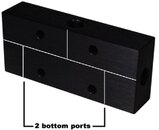phantomrfa
Registered
Hello,I was hoping that someone could help with a little problem i have?.I have been looking on the internet and found lots of usefull parts but they are mostly NTP threads((U.S)) standard .To make my life easy i need BSP .I have found the part i like but itis ntp so i am think of getting it made here in the U.K. the grade of metal is the problem what to use , is this grade going to work at 4500 psi 6082 T6 (HE30)




